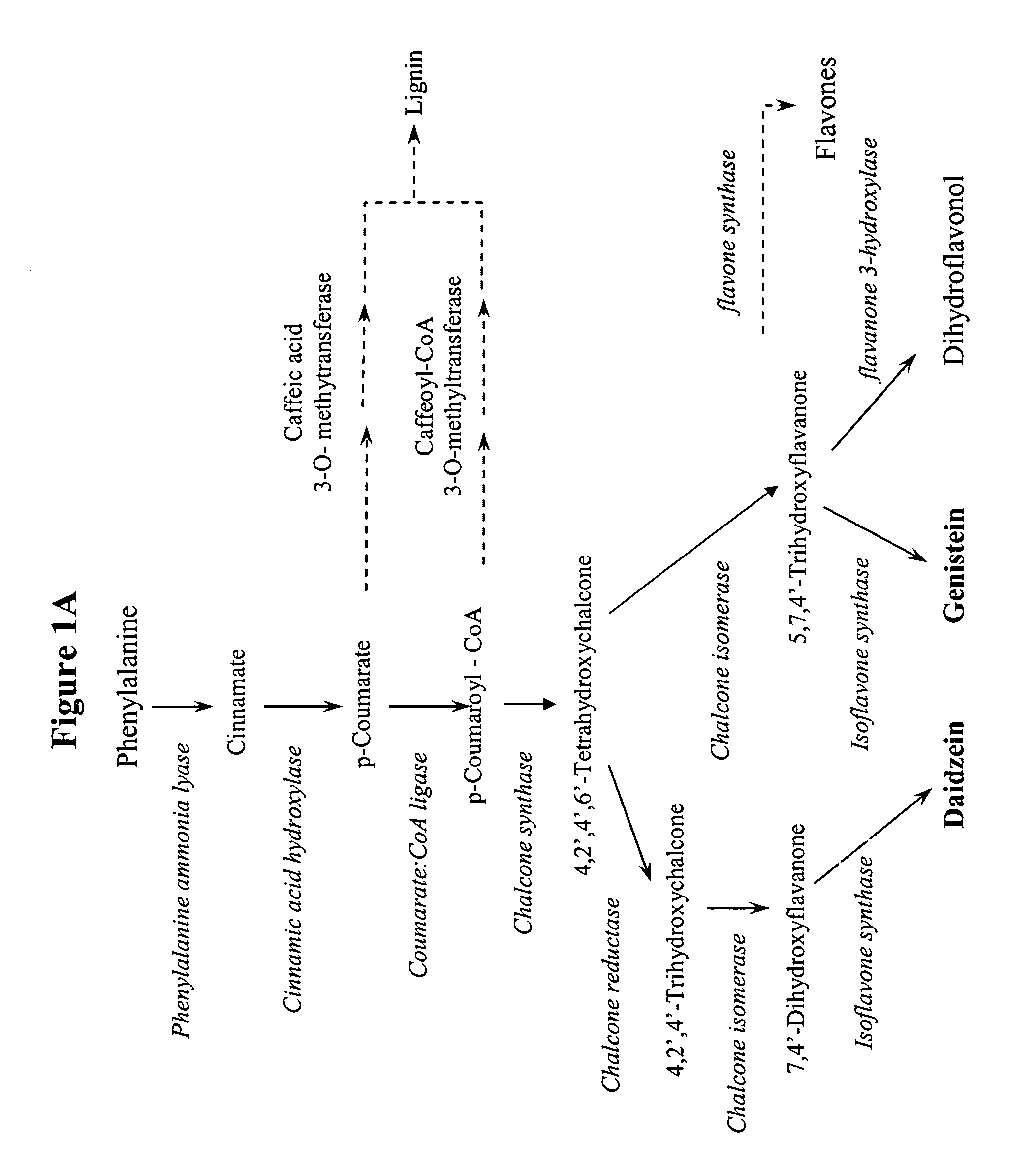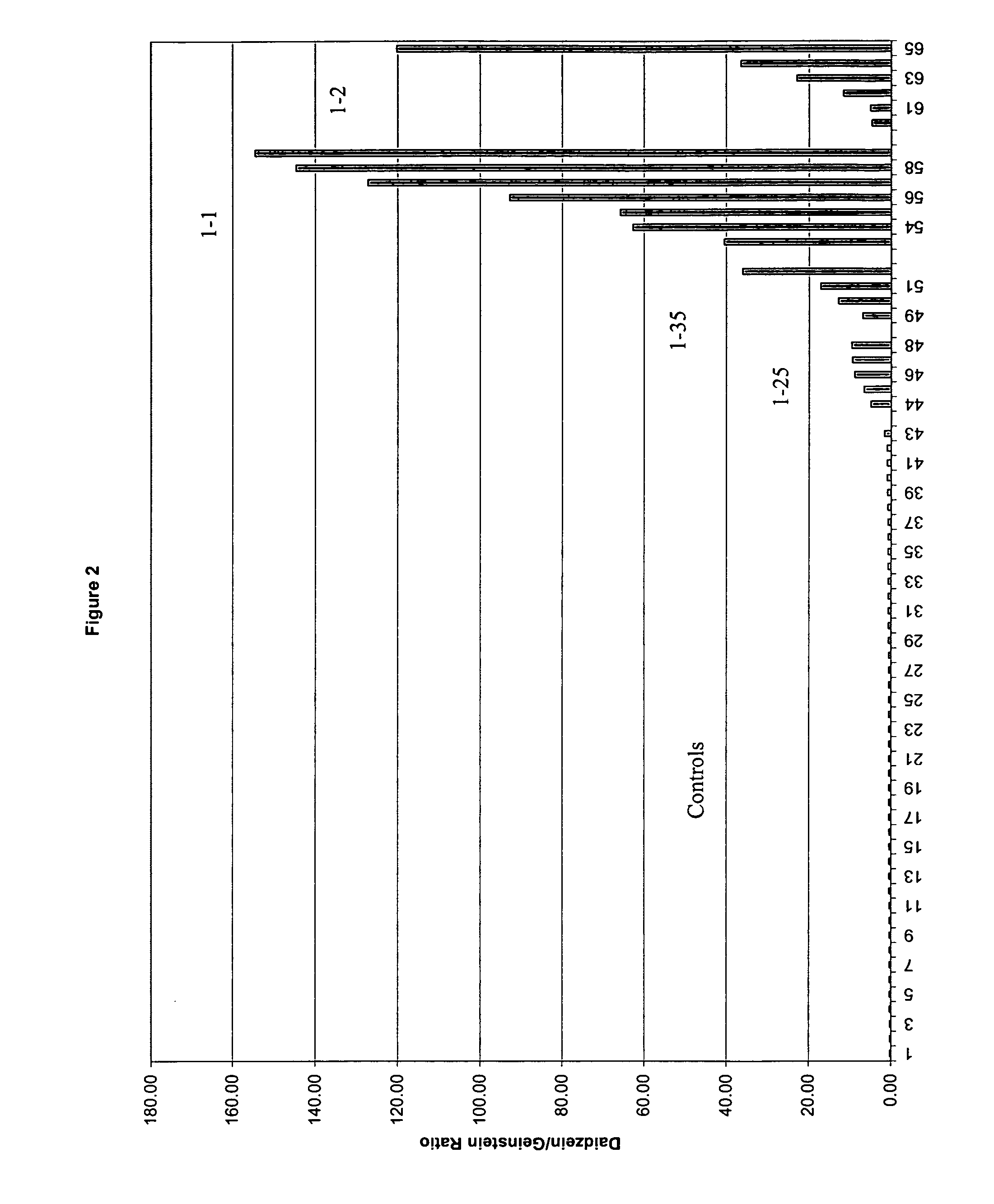Method for altering the isoflavonoid profile in the plant parts of an isoflavonoid-producing plant
a technology of isoflavone and plant parts, which is applied in the direction of plant/algae/fungi/lichens ingredients, animal repellents, vegetable proteins working up, etc., can solve the problems of inability to activate gene expression and limited isoflavone production, and achieve the effect of altering the isoflavone profile of the transformed plan
- Summary
- Abstract
- Description
- Claims
- Application Information
AI Technical Summary
Benefits of technology
Problems solved by technology
Method used
Image
Examples
example 1
Construction of Plasmids for Transformation of Glycine max
[0124] The effect on the isoflavonoid profile of soybean of a protein encoded by a recombinant DNA fragment containing maize nucleotide sequences encoding C1 and the Lc allele of R was tested. For this purpose, plasmid pOY203 was constructed for introduction of a CRC recombinant expression construct into soybean embryos. Plasmid pOY203 was briefly described in PCT publication WO 00 / 44090 (published Aug. 3, 2000) and contains a CRC recombinant DNA fragment under the control of the phaseolin promoter and termination signals in a vector containing expression systems which allow for selection for growth in the presence of hygromycin in both bacterial and plant systems.
[0125] Plasmid pOY203 was prepared through an intermediary plasmid pOY135. Plasmid pOY135 contains, flanked by Hind III restriction endonuclease sites, the CRC recombinant DNA fragment inserted between the phaseolin promoter and polyadenylation signal sequences. T...
example 2
Transformation of Somatic Soybean Embryo Cultures and Regeneration of Soybean Plants
[0136] The ability to alter the isoflavone levels in transgenic soybean plants expressing the CRC recombinant expression construct was tested by transforming soybean somatic embryo cultures with plasmids pOY203 and pWSJ001, screening for transformants expressing only the CRC recombinant expression construct, allowing plants to regenerate, and measuring the levels of isoflavones produced. The present invention does not require the presence of plasmid pWSJ001. Screening for the presence of the transgenes was performed by PCR amplification, and plants containing the isoflavone synthase recombinant-expression construct were excluded from this work.
[0137] Soybean embryogenic suspension cultures were transformed with pOY203 in conjunction with pWSJ001 by the method of particle gun bombardment, and transformants carrying the CRC recombinant expression construct in pOY203, and not the IFS recombinant expre...
example 3
[0154] Analysis of Isoflavones in R1 Seed of Transformants Containing the CRC Recombinant expression construct
[0155] Isoflavone levels were analyzed in seed from soybean primary transformants (R1 seed) containing the CRC recombinant expression construct and not the IFS recombinant expression construct. Extracts were prepared and analyzed by HPLC as follows. Each seed was weighed and placed in a 2 mL screw cap tube containing a ¼″ cylindrical bead and 20 mg flavone (as internal standard). The seed was then crushed using a bead beater at 4200 rpm for 30 second intervals until reduced to a fine powder. The sample was homogenized into solution by the addition of 800 μL of 80% aqueous methanol and further bead beating. Each sample was left in a shaking water bath at 60° C. for 4 hours and then centrifuged at 12000 rpm for 10 minutes. A 100 μL aliquot of the supernatant was removed and added to 100 μL deionized water, vortexed, centrifuged, and analyzed by HPLC. An HP 1100 instrument equ...
PUM
| Property | Measurement | Unit |
|---|---|---|
| temperature | aaaaa | aaaaa |
| temperature | aaaaa | aaaaa |
| temperature | aaaaa | aaaaa |
Abstract
Description
Claims
Application Information
 Login to View More
Login to View More - R&D
- Intellectual Property
- Life Sciences
- Materials
- Tech Scout
- Unparalleled Data Quality
- Higher Quality Content
- 60% Fewer Hallucinations
Browse by: Latest US Patents, China's latest patents, Technical Efficacy Thesaurus, Application Domain, Technology Topic, Popular Technical Reports.
© 2025 PatSnap. All rights reserved.Legal|Privacy policy|Modern Slavery Act Transparency Statement|Sitemap|About US| Contact US: help@patsnap.com



